Lea Wait's Blog, page 7
August 26, 2025
The Long Goodbye
Last month I wrote about sagging middles. You will be happy to know I’ve been working out, so there is hope the problem…. Oh, sorry, wrong middle. Back to the blog.

The End
This month, I’m talking about endings. Not mine—hopefully — but in stories. Crafting endings is the bane of my writing existence. That seems strange because the first scene I write is the climax, so the ending should be a slam dunk. It’s not. Well, that’s not accurate, it is. My problem is what comes after. Villain caught followed by a full stop is not satisfying to the reader. There needs to be more. Interaction among the characters, a drawing together and tying up of the story ends, an introduction of the new normal, something. This is hard.
I spent twenty years as a paralegal. The majority of my professional life was spent writing pleadings. The formula is simple. Introduce the problem, develop the argument, tie the threads together to support your desired outcome, and get the heck out of Dodge. It’s not your place to visualize the world beyond your conclusion. It’s your job to demonstrate to the Judge that this is the only logical result. That’s the mindset that I took to my fiction writing. It’s not wrong, it’s just too…. abrupt.
In Paul Doiron’s One Last Lie, Charley and Mike confront the villain in the backwoods of the Allagash. They sort through the red herrings and clues before the world explodes and the plot, as they say, thickens. The climax takes place over three chapters. The book continues for another two. Those additional chapters reinforce Mike and Charley’s humanity. They allow the reader to step back, breathe, and remember why they like these characters. A necessary step in a continuing series.
The same is true in Maddie Day’s Batter Off Dead. This book is very different to Paul Doiron’s. It’s a cozy, the sleuth an amateur, but the stakes are still life and death. Robbie confronts the villain alone and saves herself by using her wits. The drawing together of the plot takes place after the confrontation, and the next three chapters are devoted to Robbie resuming her place in her normal world. It’s satisfying, and hopeful at the same time.

The Long Goodbye
It seems the secret to endings is the long goodbye. Convention demands not only the capture and punishment of the villains but also the restoration of the protagonists. Whether law enforcement or amateur sleuths, crime is an affront to their humanity. It’s important for readers to experience their restoration.
Readers, do you feel cheated if a story simply ends with the capture? Writers, what’s your take on the long goodbye?
August 24, 2025
Must We Kill Our Darlings?
Sandra Neily here. (Revising and sharing a previous post I needed to hear this month.)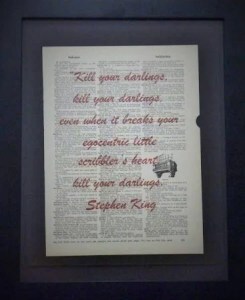
Stephen King drove the knife deep: “Kill your darlings, kill your darlings,” he wrote. “Even when it breaks your egocentric little scribbler’s heart, kill your darlings.”
I think King got the ego thing right. Cutting words we love is often painful and personal as we let the novel drive our editing. If words we love do not efficiently and tightly drive the story forward, the “darlings” have to go … but not die if we save them. into my next mystery.
Over 10 years ago I cut a scene from “Deadly Trespass.” I am glad I saved it as I am just about to bring the narrator’s mother into my next mystery.
I’ve reworked it a bit but kept this passage.
********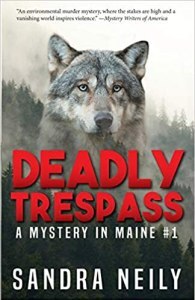
My mother had an ancient neighbor who yelled “never!” at odd moments. When we had time, Pock and I visited around the nursing home. My dog drooled and wagged like their lost pets, and often, just as friendship kicked in, we’d find an empty bed and a repainted room while Pock whined softly.
Was a nursing home in my future? The “never” screamed at me from across the hall was a good omen. My mother lay flat, looking at the ceiling. Except for her bony shoulders and the small ridgeline of her legs, she showed less mass than her rumpled bedding. She looked like a desert horizon line—brown and pink weathered rock barely visible above white sand.
Her face lifted into a wide smile. She patted the bed for Pock to jump up. “Where’s Annie. It’s time for her walk.”
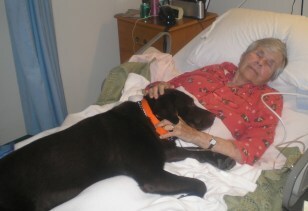
My “Jackie” with my mother … long ago.
Annie was long gone so I agreed and used the past tense at the same time. “Right, Mum. Annie was Beagle-feisty. A real ankle biter.”
I reached for the bed controls, raised her head, and stretched Pock down her side, placing his head under her fingers. Her cheeks—flawless and translucent—glowed. Only the clawed hands on my dog and her spider web strands of hair were genuine age markers. As a child I’d been careless with her china, so she’d packed it away from my dirty fingers. At ninety-two my mother was more delicate than her disappeared china. She reached for my hands and clutched them to her chin.
I lifted her nail file. “Shall we work on your hands?” I asked
I reached for a chair and dropped into it, hands supporting my pounding head. I needed water. My cells felt squeezed dry. “You asked me to come. Why?”
She shot me a sturdy stare. “You know, dear, nothing is ever lost. Your father’s not. Annie’s not. If I don’t see you for days, I know you are not lost. All of God’s creation is in its rightful place.
I moaned and collapsed over my knees.
She picked muffin crumbs from her sheets and placed them on Pock’s quivering lips. “Misplaced. Sometimes we misplace things, but God’s plan restores order. Annie is not lost. Your father is not lost. You are not lost.”
I rose and leaned over her bed, wrapping both dog and mother in my arms. “But Mum, why did you really call me?”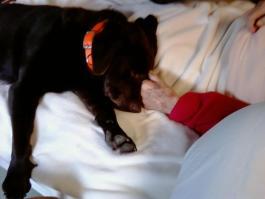
Her moist, blue eyes squinted at the wall where we’d hung a large poster of family photos. I wore a starched Easter dress and lifted a basket of eggs. My brother rowed a boatload of beagles. My parents toasted each other, heads thrown back with laughter. “I was lonely,” she whispered.
I used to tell a therapist that I’d been dropped and raised by wolves, but that didn’t really describe my childhood. Real wolf pups probably had it better. They grew up under the pack’s watchful eyes until they could hunt for themselves. There was always warm fur, fresh food, and careful surveillance.
I’d raised myself in sea cave hideouts carved by the tide or mossy thickets where I stashed canned peaches and library books. The seagulls and squirrels knew more about me than my parents did. After school I leashed a beagle and escaped up the street, never wondering why no one asked me where I was going.
I inched onto her bed and arranged my head next to her shoulder, careful not to press weight on her. Her strong pulse beat through skin so thin sheets could cut her arms. My brother and I used to put frog eggs in a fishbowl on the table and watch beating hearts develop from transparent cells. Strong life through thin tissue. My mother was not dying— just lonely.
I knew all about lonely; I’d learned it at an early age.
*******
I have a file of discarded “Darlings.” There aren’t many in it, but the ones that are, are darlings.
S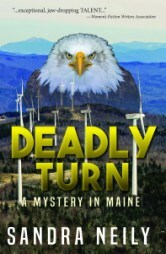 andy’s second Mystery in Maine Deadly Turn was published in 2021. Her debut novel, “Deadly Trespass, A Mystery in Maine,” won a national Mystery Writers of America award, was a finalist in the Women’s Fiction Writers Association “Rising Star” contest, and was a finalist for a Maine Literary Award. In 2026 “Deadly Harvest” will return Patton, her badly-behaved dog, and game warden Moz as they meet up with even more threatened wildlife. Find her novels at all Shermans Books and on Amazon. Find more info on Sandy’s website.
andy’s second Mystery in Maine Deadly Turn was published in 2021. Her debut novel, “Deadly Trespass, A Mystery in Maine,” won a national Mystery Writers of America award, was a finalist in the Women’s Fiction Writers Association “Rising Star” contest, and was a finalist for a Maine Literary Award. In 2026 “Deadly Harvest” will return Patton, her badly-behaved dog, and game warden Moz as they meet up with even more threatened wildlife. Find her novels at all Shermans Books and on Amazon. Find more info on Sandy’s website.
August 22, 2025
Weekend Update: August 23-24, 2025
 Next week at Maine Crime Writers there will be posts by Sandra Neily (Monday), Kait Carson (Tuesday), Dick Cass (Thursday), and a group post on Friday.
Next week at Maine Crime Writers there will be posts by Sandra Neily (Monday), Kait Carson (Tuesday), Dick Cass (Thursday), and a group post on Friday.
In the news department, here’s what’s happening with some of us who blog regularly at Maine Crime Writers:
Maureen Milliken and Kate Flora will have a table at the Designing Women Artisan Market from 9:30 to 4 p.m. today (Saturday, Aug. 23). It’s at Longfellow’s Greenhouses, 85 Puddledock Road, Manchester (just next to Augusta). The show has a lot of great artists and crafters, and the weather is expected to be gorgeous. Come on over and say hi!
Maureen Milliken will also be at the Inebri-Arts Pages & Pints Small Press Expo, 12-4 p.m. Sunday, Aug. 24, at Mayflower Brewing, Plymouth, Mass.
Matt Cost will be signing the release of The Not So Merry Adventures of Max Creed at BAM (Books-A-Million) in South Portland today (Saturday) from 1-3 PM. Details Here.
On Thursday, August 28, at 6 PM, Jule Selbo and Matt Cost will be in conversation on their writing conventions with a focus on their recent books, 7 Days and Glow Trap, respectively. Selbo and Cost will dive into how they create and get into the head of the villains to create complex and sometimes vile human beings. This will dovetail into how creating well-developed backstories for the main characters and how other minor roles and the setting make for a more richly layered and resonant story. The authors will explore the necessity and how to of creating red herrings to keep the reader guessing and the use of action in their books to keep the pages flipping without overdoing it. Mysteries are stories that build to a final climax, mano a mano, when the protagonist and the villain have a final confrontation with all the marbles on the table. What are the steps to building to and writing that final showdown? Come see what Jule Selbo and Matt Cost have to say on that and other writing techniques. It promises to be a mysterious, illuminating, and good time. DETAILS HERE.
On Saturday, August 30, from 1-3 PM, Matt Cost will be celebrating the launch of his most recent, Glow Trap, in the town where the book is set. Port Essex is based on the town of Boothbay Harbor and Glow Trap is the sixth and final one in the series. Come to Shermans Maine Coast Bookshop in Boothbay Harbor and leave with a signed copy that will keep you turning pages late into the night. Details Here.
An invitation to readers of this blog: Do you have news relating to Maine, Crime, or Writing? We’d love to hear from you. Just comment below to share.
And a reminder: If your library, school, or organization is looking for a speaker, we are often available to talk about the writing process, research, where we get our ideas, and other mysteries of the business, along with the very popular “Making a Mystery” with audience participation, and “Casting Call: How We Staff Our Mysteries.” We also do programs on Zoom. Contact Kate Flora
August 21, 2025
Maine summer and writing and reading stuff
Not impressed with that title? Well, you can join the club. I had a bunch of great topics, and was going to choose at least one of them to write about today, but I went for a drive instead.
Don’t judge me.
Summer is almost over and I’ve barely noticed it started. I should have been, today, working on my book that’s in major danger of not making my editor’s deadline, working on the many articles I have due before the month is over for my day job, or if not that stuff, at least figuring out what the smell coming from the kitchen sink drain is.
But it is a lovely perfect summer day in Maine — and we don’t get a ton of those — and so around 9 a.m. I got in the car and drove. My drive took me through Waldo County, up to Frankfort, and back home by another route. By the time I stopped at the Hannaford in China to pick up some stuff (I forgot the cat food!), my head was almost clear.

Frankfort, Maine, and the north branch of the Marsh River on a beautiful August day.
When we talk about writing process and all that stuff, one thing we probably don’t talk about enough is giving everything a break once in a while. You often hear that you HAVE TO write every day, you HAVE TO write so many words, you HAVE TO blah blah blah. Well, the biggest HAVE TO is powering down and giving your brain some time off, even if you’re behind on things.
In fact, driving around aimlessly, besides being really enjoyable, also tends to generate ideas and get my book working in my head in a way that’s also much more productive than typing on a keyboard.
By the way, here are some of the things I was going to write about:
I read an op/ed in the Boston Sunday Globe a couple of weeks ago lamenting the fact that if men aren’t reading as much fiction as they used to, it’s because no one is publishing books men want to read. Yes, that’s a huge generalization of the piece, but it’s my overall takeaway. The author seemed to conflate increased marketing of books for and by people of color and women, and about social issues, as meaning there are no books being published for men anymore. He did suggest that you can still read Hemingway or whoever. I was going to write a thoughtful analysis for this post today, but my brain isn’t there and what little I have in it is reserved for the (non-manly) book I am writing. So all I can say about it is:
Are you efffing kidding me? OF COURSE there are books by and for men, and definitely for men who don’t want to read about social issues. The publishing and reviewing industry has notoriously favored male writers and their books, and if the pendulum is swinging the other way, it’s still not quite there yet. If you aren’t being spoon fed information about books by and for men at the rate you’re used to, do what the rest of us have been doing for centuries. Go to the bookstore or library, look at all the books, and when you find one that you like, take it home to read. Problem solved.
Another topic I’d thought of tackling:
I read an article this morning that people in general are reading less for pleasure than they used to. This includes audio books, digital, etc. There were some theories why (people are working too hard because of the economy. Yeah right). My theory is that we have so many options to stream, who the hell wants to sit down with a book? But the study didn’t ask people why, so we’re left to figure it out for ourselves.
Again, I don’t have the mental power to do any kind of thoughtful analysis. I will say that anecdotally, at almost every event where I have an author table, someone has to announce to me that they don’t read. So my bottom line on this topic is what I always say to those people: That’s too bad.
That’s all I can summon today. Summer in Maine is short. Go out and enjoy it.
Glow Trap. The Final Trap.
I currently have four crime series out in the world. Two contemporary Maine, one historical, and one thriller series. I have another series set to debut in October of 2026. And there is a sixth series being shopped around.
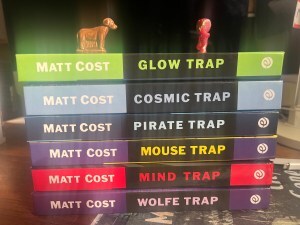
That is a serious amount of series. Sorry. But on August 13th, something new happened. While sequels have been piled on one after another in my mystery novels, for the first time, I have ended the sequence. Glow Trap, published eight days ago, is the Final Trap.
In an interview once, I was asked how I knew it was time to end a series. My answer at the time was that I have no idea, I have never done that. My reasoning now is that Clay Wolfe as we know him just plain seemed to have run his course. It was time to say goodbye to Port Essex, Baylee, Crystal, Westy, Murphy, and Cloutier.
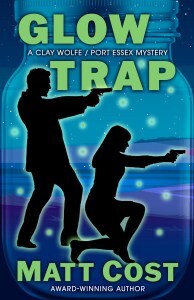
Glow Trap ties together and unravels quite a few threads all at the same time. A documentary film crew wants to make a movie based on Baker & Wolfe Private Investigators. A man with an alias washes up on shore dead. A trio of suspects included a retired spy, a former gangbanger in the WITSEC program, and a wealthy art thief hiding out in Port Essex.
Order on Amazon. Or from Booshop.org. Or Ingram.
In a blast from the past, the idea is floated that the death of Clay’s father, mother, and grandmother when he was just a child was not just an accident. That a man who Mack Wolfe had put away for dealing drugs had reached out from prison and snuffed their lives in revenge.
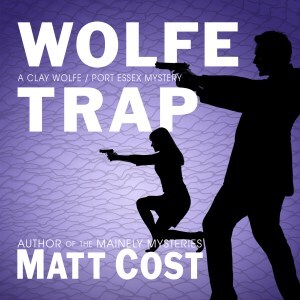
The pharmaceutical billionaire that Clay built a case against in Wolfe Trap has the charges dismissed due to technicalities that most likely involve bribes and blackmail. Is he ready to let bygones be bygones or is he set on a path of retribution?
Goodbyes are always difficult. But it is time to say goodbye to Port Essex.
The fireworks are so explosive, the action so packed, and the suspense so tight—it only seemed right to cap the climax and call it complete.
Glow Trap. The Final Trap. Or is it?
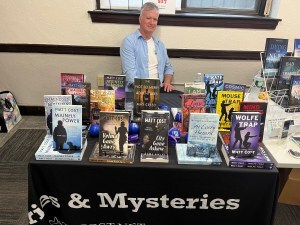
About the Author
Matt Cost was a history major at Trinity College. He owned a mystery bookstore, a video store, and a gym, before serving a ten-year sentence as a junior high school teacher. In 2014 he was released and began writing. And that’s what he does. He writes histories and mysteries.
Cost has published six books in the Mainely Mystery series, starting with Mainely Power. He has also published five books in the Clay Wolfe Trap series, starting with Wolfe Trap. And finally, there are two books in the Brooklyn 8 Ballo series, starting with Velma Gone Awry. For historical novels, Cost has published At Every Hazard and its sequel, Love in a Time of Hate, as well as I am Cuba. The Not So Merry Adventures of Max Creed began a new series this past April. Glow Trap is his eighteenth published book.
Cost now lives in Brunswick, Maine, with his wife, Harper. There are four grown children: Brittany, Pearson, Miranda, and Ryan. They have been replaced in the home with four dogs. Cost now spends his days at the computer, writing.
August 19, 2025
When Are You Going to Write a Real Book?
 Kate Flora: When we’re not at our desks, writers spend a lot of time in bookstores and libraries talking about our books and the writing process. Over the years, there have been some questions that are on repeat and some that are real surprises. I think the topic of this post, when am I going to write a real book, might be the biggest surprise.
Kate Flora: When we’re not at our desks, writers spend a lot of time in bookstores and libraries talking about our books and the writing process. Over the years, there have been some questions that are on repeat and some that are real surprises. I think the topic of this post, when am I going to write a real book, might be the biggest surprise.
I tried not to snarl when the question was asked. (I think this one was in an email, not face-to-face.) Instead, I described my ten years in the unpublished writer’s corner, where I refined both my craft and my cover letter, to get where I am today. I said that I believe I DO write real books, books that explore the nature of evil, the development of character, the relationship between setting and story, that create the balance between solving the story arc in each individual book and continue to develop the character arc over the course of the series. I don’t know if the person who posed the question was satisfied. There are certainly many other there—writers and readers alike—who believe that only literary fiction has value and genre fiction does not.
These people are not happy when I say that “literary fiction” is merely another genre.
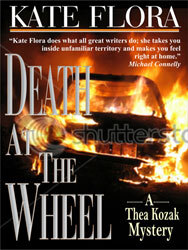 One question that I’ve gotten with some frequency over the years was whether, given the tense relationship between Thea and her mother, Thea’s mother was based on my own mother. The first time it was asked, I was shocked. I said no, definitely not, that my mother was one of my heroes. The follow-up question was: then where does she come from? It’s always interesting to hear what readers focus on, isn’t it? Anyway, I pondered on the question and decided that much of Thea’s mother’s difficult character was a blend of my two grandmothers. One was a witch; the other, superficially sweet, was an accomplished manipulator who had to have her way.
One question that I’ve gotten with some frequency over the years was whether, given the tense relationship between Thea and her mother, Thea’s mother was based on my own mother. The first time it was asked, I was shocked. I said no, definitely not, that my mother was one of my heroes. The follow-up question was: then where does she come from? It’s always interesting to hear what readers focus on, isn’t it? Anyway, I pondered on the question and decided that much of Thea’s mother’s difficult character was a blend of my two grandmothers. One was a witch; the other, superficially sweet, was an accomplished manipulator who had to have her way.
A similar question was: Is Thea based on me? I said look. Am I nearly six feet tall, with wild, dark curly hair and an impressive chest? Am I as brave as a barrel full of bears? No, I said. I am the mother of two boys. I always wanted a daughter, and I expect, had I had one, she would have been as courageous and headstrong as Thea. There have definitely been times over the course of the books when she’s gone off to do something against my advice (our characters absolutely do that) and I worried until she was out of danger.
I was asked the “real book” question before I took that detour into writing nonfiction. 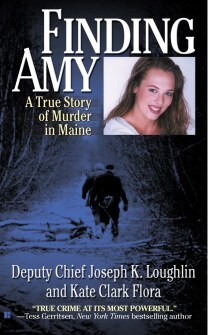 Sometimes I wonder whether the questioner would consider Finding Amy: A True Story of Murder in Maine, a real book. What about Death Dealer: How Cops and Cadaver Dogs Brought a Killer to Justice. And certainly my cowritten nonfiction about police shootings from the police point of view, Shots Fired, is a real book, even if it isn’t literary fiction. For those books, there are questions like whether my co-writer, Joe Loughlin, had a thing for Amy’s mother. And my all time favorite (NOT) from a question asked when I was speaking at the Unitarian church about Shots Fired. After explaining that the book was about actual experiences by police officers in tense shooting situations, and the consequent effects on them psychologically as well as on their careers, one woman said, “Wouldn’t the book be better if it included the black point of view?”
Sometimes I wonder whether the questioner would consider Finding Amy: A True Story of Murder in Maine, a real book. What about Death Dealer: How Cops and Cadaver Dogs Brought a Killer to Justice. And certainly my cowritten nonfiction about police shootings from the police point of view, Shots Fired, is a real book, even if it isn’t literary fiction. For those books, there are questions like whether my co-writer, Joe Loughlin, had a thing for Amy’s mother. And my all time favorite (NOT) from a question asked when I was speaking at the Unitarian church about Shots Fired. After explaining that the book was about actual experiences by police officers in tense shooting situations, and the consequent effects on them psychologically as well as on their careers, one woman said, “Wouldn’t the book be better if it included the black point of view?”
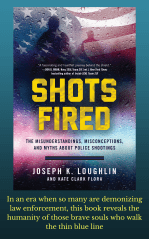 One of those moments when I realized I had several great answers a few hours later. And she never did get that some of the officers involved in those shootings were black.
One of those moments when I realized I had several great answers a few hours later. And she never did get that some of the officers involved in those shootings were black.
There will always be great questions, weird questions, annoying questions, and questions that teach us about our writing. One of my favorites was the reader who asked, about one of my Joe Burgess police procedurals, what I expected my readers to take away from the book. Probably I should have, but I’d never thought of it before. I was wrapped up in storytelling, and craft, and character. But of course, when I look at any book, or look at the arc of a series, I can see a lot of questions woven throughout the narratives. At bottom, they are about the contest between good and evil and who will fight for good. And about the ripple impacts of crime not only on the victim but on the others around that victim.
August 17, 2025
Cameos
Kaitlyn Dunnett/Kathy Lynn Emerson here. The other day I was watching Iron Man 2 (2010) for the umpteenth time (yes, I look for sheer escapism in my streaming choices) when I saw something I’d never noticed in any of my previous viewings. There, in an early party scene, the character of Tony Stark spots someone he knows and greets him by name—Elon. Yep, that Elon. They exchange a tiny bit of dialog before the action moves on.
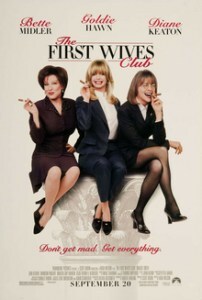 I don’t know why this surprised me. Have you ever noticed how many movies Donald Trump has had cameos in? Strange, for a guy who continually badmouths the liberal leanings of Hollywood. And then, of course, there is the brief appearance of his late ex-wife, Ivana, in The First Wives Club (1996), in which she delivers the immortal line: “Ladies, you have to be strong and independent, and remember, don’t get mad, get everything.”
I don’t know why this surprised me. Have you ever noticed how many movies Donald Trump has had cameos in? Strange, for a guy who continually badmouths the liberal leanings of Hollywood. And then, of course, there is the brief appearance of his late ex-wife, Ivana, in The First Wives Club (1996), in which she delivers the immortal line: “Ladies, you have to be strong and independent, and remember, don’t get mad, get everything.”
There are obviously lots of cameos in films. Many use real newspeople if they need to have a character interviewed—The First Wives Club again, with Kathie Lee Gifford. Both Alfred Hitchcock and Stan Lee made a habit of appearing somewhere in many of the movies they were associated with, Hitchcock as director and Lee as the face of Marvel Comics.

One classic film that went overboard in celebrity appearances was The List of Adrian Messenger (1963), in which numerous members of Hollywood royalty appear, heavily disguised, and unmask at the end of the movie. There are also many films were celebs appear but are not credited, making it a challenge to spot them. I remember getting a kick out of seeing Noelle Niell, the first Lois Lane (from the 1950s TV series), make a brief appearance in Superman, the Movie. If you blinked, you missed it.
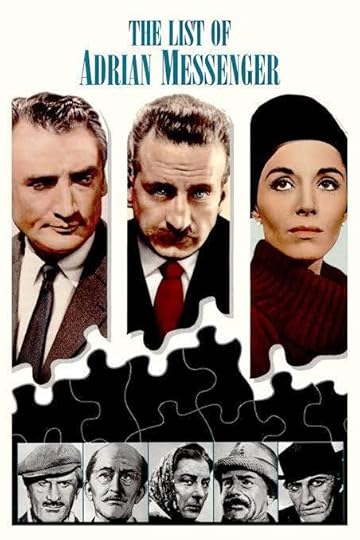
But what does any of that have to do with books, let alone mysteries? Or with Maine, for that matter? Real people sometimes appear in novels, too, and not just historical tomes or when the author has fictionalized a real person to make them the detective. Scotched (2011), Liss MacCrimmon Mysteries #5 (written as Kaitlyn Dunnett) takes place at the fictional Maine Cozy-Con, attended by both real Maine mystery writers and a couple I made up. I also wrote myself in as an attendee. I’m the local writer whose name Liss can never remember.
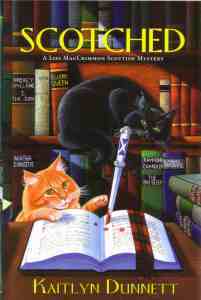
What examples of walk-on roles for celebrities, in books or movies, spring to your mind? Share, please. The comment section is just below.

Kathy Lynn Emerson/Kaitlyn Dunnett has had sixty-four books traditionally published and has self published others. She won the Agatha Award and was an Anthony and Macavity finalist for best mystery nonfiction of 2008 for How to Write Killer Historical Mysteries and was an Agatha Award finalist in 2015 in the best mystery short story category. In 2023 she won the Lea Wait Award for “excellence and achievement” from the Maine Writers and Publishers Alliance. She was the Malice Domestic Guest of Honor in 2014. She is currently working on creating new editions of her backlist titles. Her website is www.KathyLynnEmerson.com.
August 15, 2025
Weekend Update: August 16-17, 2025
 Next week at Maine Crime Writers there will be posts by Kaitlyn Dunnett/Kathy Lynn Emerson (Monday), Kate Flora (Tuesday), Matt Cost (Thursday), and Maureen Milliken (Friday).
Next week at Maine Crime Writers there will be posts by Kaitlyn Dunnett/Kathy Lynn Emerson (Monday), Kate Flora (Tuesday), Matt Cost (Thursday), and Maureen Milliken (Friday).
In the news department, here’s what’s happening with some of us who blog regularly at Maine Crime Writers:
Matt Cost: Glow Trap is now out! Order it HERE. Check out this interview on Big Blend Radio about Glow Trap. Here.
MAINE CRIME WAVE – New format and fun. NOIR AT THE BAR, an evening event, September 26 at NOVEL BOOKSTORE/BAR/COFFEESHOP on Congress Street in Portland. Come hear crime writers read from their work and win prizes! Then September 27, an all day event at historic MECHANICS HALL on Congress Street in Portland. Lots of roundtables where small groups will discuss tips, craft, the business of writing crime, publishing, finding a publisher or representative and more with published authors and those who are now finding their way. Registration is NOW OPEN.
2-4 pm TODAY. TODAY, August 16, is “come read and get feedback” on your work at mystery writer/Sisters in Crime member Jule Selbo’s home on Munjoy Hill in Portland. This is organized by mystery writer (short story fiend and Sisters in Crime planner ) Gabriela Stiteler. Not too late to “drop in” today. Just email Jule at juleselbo@gmail.com
An invitation to readers of this blog: Do you have news relating to Maine, Crime, or Writing? We’d love to hear from you. Just comment below to share.
And a reminder: If your library, school, or organization is looking for a speaker, we are often available to talk about the writing process, research, where we get our ideas, and other mysteries of the business, along with the very popular “Making a Mystery” with audience participation, and “Casting Call: How We Staff Our Mysteries.” We also do programs on Zoom. Contact Kate Flora
August 14, 2025
Brevity and Velocity
Rob Kelley here, musing this week on short books that pack a punch.
One of the things I really like about The Writer’s Hotel writing conference is the “Major Workshop,” a critique and craft group led by a senior writer. I was lucky enough to be in one led by Jeffrey Ford, who is an amazing writer and a great coach. I also had the opportunity to read and be read by seven other talented writers, some published multiple times, some (like me) about to debut, and some earlier in their writing journey. Because this a conference that participants must apply for, we were guaranteed high quality engagement with fellow authors, and Jeff’s Major Workshop delivered.

It was my critique work of other authors that raised the concept of brevity. In two of my critiques I was making a point about tightening prose to move the action along, and the example that popped into my head unbidden was Ursula LeGuin’s 1968 novel A Wizard of Earthsea.
This is the cover my copy has, which is from a Bantam Books printing from 1973 (which I bought used for 75¢ at a used bookstore. Those were the days!). I probably read it for the first time in early high school in the late ’70s. I reread it multiple times in the following years then put it away as my tastes expanded and evolved. But it came to mind as I was doing my critiques as an example of a masterclass in brevity.
In 56,000 words, LeGuin builds a world, gives us its history, introduces us to a boy who grows into a man who must face the consequences of using his considerable power in a vain and foolish youthful act that threatens him and those around him. In the meantime, we learn the geography of the Earthsea archipelago (the included maps are fabulous), a bit of the old tongue that gives a wizards their power, all while following the wizard on multiple adventures to previously uncharted land. That’s a lot in 56,000 words.
How is she able to do so much in so few words? Specificity. Everything is grounded in detail. Each sentence works extra hard to build the world, set the tone, give a voice to the protagonist. Now this is fantasy novel, which has certain conventions that make this easier, but I could just as easily used as an example from the crime and thriller canon.
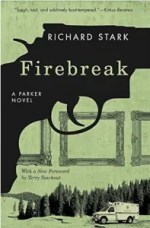 That example (those examples) would be the Parker novels by Richard Stark, a.k.a. Donald E. Westlake. (Huge shoutout to fellow Maine thriller writer Chris Holm for introducing me to Parker in his “Unputdownable” master class!)
That example (those examples) would be the Parker novels by Richard Stark, a.k.a. Donald E. Westlake. (Huge shoutout to fellow Maine thriller writer Chris Holm for introducing me to Parker in his “Unputdownable” master class!)
Number 20 in the series, Firebreak, opens with what I think is the single best line in any crime fiction, anywhere:
When the phone rang, Parker was in the garage, killing a man.
Now that’s an opening. It tells you a lot about Parker, a lot about the situation we’re in, or about to be in. And in the 40,000 words that follow we get everything we expect from Parker: heists, plans gone wrong, betrayals, and revenge. Across 24 books we see a hard man do sometimes unspeakable things and we’re holding on for dear life as we follow along. Extremely brief, and again, very specific. The immediacy. The phone. The garage. The killing. Our only conclusion: it’s about to get worse.
Both LeGuin and Westlake were masterful writers, ones I try hard to emulate: the brevity, the specificity, and most importantly for thriller writers, the velocity.
What’s your favorite opening line that kicks off a real barn burner of a book?
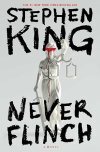 Currently reading: Never Flinch, Stephen King, 2025.
Currently reading: Never Flinch, Stephen King, 2025.
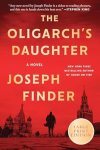 Next from the TBR list: Oligarch’s Daughter, Joseph Finder, 2025.
Next from the TBR list: Oligarch’s Daughter, Joseph Finder, 2025.
Four Things
Here are a four things that I’ve been thinking about.
Two Books
I recently finished reading two books. Megan Abbott’s EL DORADO DRIVE and William Boyle’s SAINT OF THE NARROW STREET.
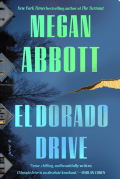 Abbott weaves forward and backward timelines from 2008 stretching back to the childhood of the three sisters in Grosse Pointe, MI. While not overtly historical feeling, there is a certain nostalgia and tenderness to an otherwise ugly and complex situation involving a pyramid scheme, betrayal, and ultimately murder. Abbott goes deep and stays there. As with her other writing, she explores the bonds between women, a sense of connectedness and isolation, and a world where nobody comes out ahead.
Abbott weaves forward and backward timelines from 2008 stretching back to the childhood of the three sisters in Grosse Pointe, MI. While not overtly historical feeling, there is a certain nostalgia and tenderness to an otherwise ugly and complex situation involving a pyramid scheme, betrayal, and ultimately murder. Abbott goes deep and stays there. As with her other writing, she explores the bonds between women, a sense of connectedness and isolation, and a world where nobody comes out ahead.
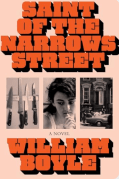 In Boyle’s story, also set in the near historical and stretching forward in time, two sisters commit a murder and spend the rest of the novel trying to keep it buried. Like Abbott, Boyle respects his characters enough to allow them to develop in complex, flawed ways. The setting, time, and place felt familiar, reminding me of people I might have known at one point.
In Boyle’s story, also set in the near historical and stretching forward in time, two sisters commit a murder and spend the rest of the novel trying to keep it buried. Like Abbott, Boyle respects his characters enough to allow them to develop in complex, flawed ways. The setting, time, and place felt familiar, reminding me of people I might have known at one point.
I highly recommend both books.
Pittsburgh and the Brentwood Heist of 1982
These books made me feel oddly nostalgic for the edges of my childhood in Pittsburgh during the 1980s. Which led me to looking at old family pictures of my grandparents and my parents and even older relatives I don’t really remember. Which let me to listening to 1980s Pittsburgh punk bands. Which led me to looking up old dive bars and music venues. Which led me to learning about the Brentwood Heist of 1982, during which two men dressed as FBI agents and stole 2.8 million from a Purolator armored truck terminal and disappeared.
Poof.
Which made me think, man would that make a good story.
So I’ve been drinking deep from the heist well – movies, short stories, and books. I have some stellar recommendations and might organize a post about this at a later time.
The Great State of Maine
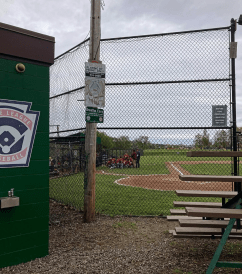 On Tuesday, my older son had his last summer ball game. He pitched well had a few solid hits, and really enjoyed himself. For those of you familiar with Portland, his home field is the one at Payson with views of Back Cove. Behind the field, the Friends of Payson Park organized a concert by the FLUKES (Fun-Loving-Ukulelele-Society). High schoolers were playing softball on the adjacent field. The pickleball court was popping. The ultimate frisbee people were making the rounds drinking things in cans with coozees. And the people dressed in medieval armor were sword fighting.
On Tuesday, my older son had his last summer ball game. He pitched well had a few solid hits, and really enjoyed himself. For those of you familiar with Portland, his home field is the one at Payson with views of Back Cove. Behind the field, the Friends of Payson Park organized a concert by the FLUKES (Fun-Loving-Ukulelele-Society). High schoolers were playing softball on the adjacent field. The pickleball court was popping. The ultimate frisbee people were making the rounds drinking things in cans with coozees. And the people dressed in medieval armor were sword fighting.
I was walking back thinking a little about how nice that moment was, how nice it is that we have a big green park by our house. How nice it is that a high school kid volunteers to coach a middle school summer ball team. How nice it is that people volunteer their time to organize concerts in the park. How nice it is that the parks put in those frisbee baskets for people. How nice the parent behind me was for saying things like, “Wow. He’s really throwing well this game.”
My Writing
I have four stories out since my last post:
 “The Usual Reasons” in Ellery Queen Mystery Magazine (July/August) Available in Barnes and Nobels and Books a Millions and maybe your local bookstores.
“The Usual Reasons” in Ellery Queen Mystery Magazine (July/August) Available in Barnes and Nobels and Books a Millions and maybe your local bookstores.
“For Laura” in Stone’s Throw (July). Available for free HERE.
 “Beautiful, Dangerous Things” in Dark Yonder (available end of August).
“Beautiful, Dangerous Things” in Dark Yonder (available end of August).
“A Hard Night’s Sleep” In Ellery Queen Mystery Magazine (September/October).
Until next time,
Gabi
Lea Wait's Blog
- Lea Wait's profile
- 507 followers



